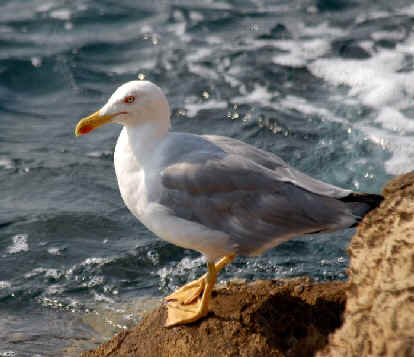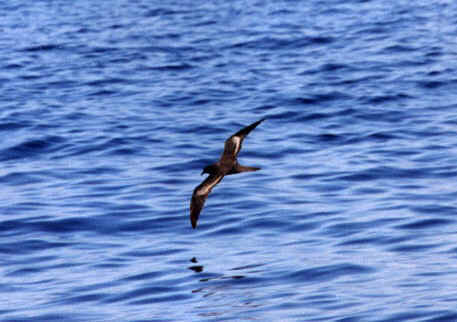
E-mail: font@focusonnature.com
Phone: Toll-free in USA 1-800-721-9986
or 302/529-1876; Fax: 302/529-1085
 |
PO Box 9021,
Wilmington, DE 19809, USA E-mail: font@focusonnature.com Phone: Toll-free in USA 1-800-721-9986 or 302/529-1876; Fax: 302/529-1085 |
A Birding
& Nature Tour
in
the
Archipelago of
the
Canary
Islands
Particularly on the
islands of
Tenerife, Gomera, and Fuerteventura
The habitats that
occur are diverse,
the birding interesting, to say the least!
June 27 - July 2, 2010
(tour:
FON/SP-3 '09)
This
tour follows
tours FON/SP-1 & 2 in Spain.
Tour to be led by Armas Hill.
Link:
List of Birds during previous FONT tours in Spain (including the Canary Islands)
List of Birds during previous FONT Tours in Europe (with photos)

The Yellow-legged Gull
is very common in the Canary Islands.
(photo by Howard Eskin)
Itinerary:
Sun, June 27:
The flight to
Tenerife, in the Canary Islands.
For those coming from tour FON/SP-2, the flight will be from Barcelona to Tenerife.
After our first birding
in the Tenerife area, overnight there.
Mon, June 28:
A full-day of birding, including "pelagic trips" by ferry, to and from
the
island of La Gomera. During each
of the two 1½ hour ferry crossings, there will be the opportunity to view the seabirds
of the Canarian waters, including Bulwer's Petrel and
Macaronesian (formerly part of the
Little)
Shearwater.
Pilot Whales and dolphins also
occur.
Earlier in the morning, on Tenerife, we'll be visiting the laurel forest,
with 2 endemic
species of pigeon: one, the Laurel Pigeon, the other,
the Bolle's Pigeon. Both species are relicts from pre-historic times.
In the
afternoon, when back to Tenerife, there will be some birding in the southern dry sector of the
island. Another overnight on Tenerife.

A Bulwer's
Petrel between islands in the Canaries.
Tue-Thu, June 29 - July 1:
During
these days, we'll explore and bird on the islands of
Tenerife and Fuerteventura.
The schedule
pertaining to the visit to Fuerteventura would be dependent upon
the timing of flights.
During our time on Tenerife,
we'll look for the rare Blue Chaffinch, the Canary,
the Plain Swift, and the Canary Islands Kinglet (also
known as the "Orangecrest", closely related to the
European bird called the Goldcrest). All of these species are confined to the
Canary Islands or nearby Madeira.
During our 2-day stay on the
island of Fuerteventura, we'll look for the
specialty birds including:
the endemic Canary Islands Chat,
a pale bird resembling both the Stonechat and the Whinchat;
the
Berthelot's Pipit, another Canary Island endemic.
Also, the
Houbara Bustard. The island of Fuerteventura may be the best place to see
this magnificent bird of the semi-desert, a species ranging as
far east as Pakistan (in much of that range, critically
endangered). Nights on Fuerteventura will be in a comfortable
hotel. The night of July 1 to be on Tenerife, as our flight from the Canary
Islands would depart from there the next morning.
Fri, July 2:
Flight from Tenerife to
Madrid, connecting with flights departing from Spain. Arrival
back in North America the same day.
Price, in US dollars, based on double occupancy:
| $1,895 Single supplement: $285 |
Price includes:
All overnight accommodations and land transportation within the Canary Islands. Most meals (breakfasts and lunches).
Price does not include:
Dinners.
Drinks and other items of
a personal nature.
Flights to/from, or within, Spain
& the Canary Islands.
Gratuities.
A deposit of $400 will assure a
place on the tour.
![]()
Some
general information about islands to be visited:
During our tour in the Canaries, 3 of the 7 main islands of the archipelago will be visited: those known as Tenerife, Gomera, and Fuerteventura. Each island is very different from the others.
On each, in addition to the birdlife, there are certainly other aspects of nature to be noted.
At sea level, the island of Tenerife has a rocky shoreline. But it also has a peak way above the sea: El Teide, at 12,160 feet, not only the highest in the Canary Islands, but the highest in Spain. At El Fraile, on the northern cliffs, there is one of the richest botantical assemblages to be found - 300 species of flowering plants in just a few hectares.
Gomera Island can only be approached by sea - by ferry. There's a steady stream of clouds over the island's peaks, often keeping them from view. Beneath the moisture-laden clouds, there is some of Spain's most luxuriant vegetation.
In contrast, the dry island of Fuerteventura is the closest of the Canaries to Africa. On the island, the dunes and the Jandia Peninsula are very interesting botanically, with a number of rare and endemic species of plants. Of particular interest is the blue-flowered viper's bugloss. and there's a succulent spurge species, resembling a red-flowered spiny cactus.